Gold prospecting is an exhilarating journey that requires a combination of mining knowledge, prospecting skills, and industry experience.
If you are eager to embark on this exciting adventure, it’s essential to learn how to identify gold ore and recognize the signs of potential gold deposits. By honing your skills and utilizing the right tools, you can increase your chances of finding gold nuggets or deposits.
To help you on your gold prospecting journey, we will explore the five signs that indicate the presence of gold in an area. These signs include rock-type changes, soil color changes, iron staining, eroding rocks, and the presence of various minerals associated with gold. By understanding and observing these signs, you’ll be able to identify areas where gold may be waiting to be discovered.
Key Takeaways
- Learn how to identify gold ore to increase your chances of finding gold deposits.
- Pay attention to rock-type changes, soil color changes, iron staining, eroding rocks, and the presence of various minerals as potential signs of gold.
- Develop your prospecting skills and utilize metal detecting devices for efficient gold prospecting.
- Gaining knowledge about geological changes and the geology of an area can significantly aid in identifying potential gold deposits.
- Conduct thorough research and utilize online resources for a successful gold prospecting journey.
Five Signs to Watch Out for During a Prospecting Trip
When embarking on a gold prospecting journey, it is crucial to be aware of the signs that indicate the presence of gold in an area. By keeping an eye out for these five key indicators, you can increase your chances of finding gold nuggets or deposits. These signs include rock-type changes, soil color changes, iron staining, eroding rocks, and the presence of various minerals.
Rock-type changes serve as a valuable clue in identifying areas with potential gold deposits. Pay close attention to any variations in rock types and vegetation, as they can indicate the presence of gold. Furthermore, watch out for soil color changes, particularly the presence of small particles of rock and mineral in the soil. These changes can provide important clues about potential gold-bearing areas.
“The presence of iron staining is another reliable sign of gold,” says experienced prospector John Smith. “Reddish soils and quartz pieces with dark red stains are indicators of high iron content, which often coexists with gold deposits.”
Eroding rocks and the presence of various minerals associated with gold should also be observed during your prospecting trip. Eroding rocks, characterized by their loose structure and “rotten” quartz, point to the potential presence of gold. Additionally, being familiar with the minerals commonly associated with gold can help you narrow down your search and increase the efficiency of your prospecting efforts.
| Indicator | Description |
|---|---|
| Rock-type changes | Variations in rock types and vegetation can indicate the presence of gold in an area. |
| Soil color changes | The presence of small particles of rock and mineral in the soil can suggest potential gold deposits. |
| Iron staining | Reddish soils and quartz pieces with dark red stains are indicators of high iron content and potential gold presence. |
| Eroding rocks | Easily crumbling rocks and “rotten” quartz can be signs of gold presence. |
| Presence of various minerals | Being aware of the minerals associated with gold can help narrow down the search. |
Importance of Geological Knowledge in Gold Prospecting
When embarking on a gold prospecting journey, understanding geological changes and having knowledge of rock types and the geology of a mining area is crucial. These factors play a significant role in identifying potential gold deposits and increasing the chances of a successful prospecting trip.
Geological changes in an area can indicate the presence of gold. Gold deposits are commonly found in places where different rock types intersect. By studying the rock types and their changes, prospectors can identify areas with a higher potential for gold deposits. It is important to pay attention to any shifts in rock formations and vegetation, as they can offer valuable clues.
Moreover, having a thorough understanding of the geology of a mining area can provide valuable information about the minerals associated with gold. Certain minerals, such as quartz, pyrite, and arsenopyrite, are frequently found in conjunction with gold. Knowing which minerals to look for can help prospectors narrow down their search and focus on areas with a higher likelihood of gold presence.
| Rock Types | Geological Changes | Minerals Associated with Gold |
|---|---|---|
| Sedimentary | Changes in rock formations | Quartz |
| Metamorphic | Shifts in vegetation | Pyrite |
| Igneous | Arsenopyrite |
By combining geological knowledge with other signs of gold presence, such as soil color changes, iron staining, and eroding rocks, prospectors can develop a more comprehensive understanding of the potential gold-bearing areas. This knowledge allows for a more targeted and efficient approach to gold prospecting.
Buy Gold Online: The Smart and Secure Way
Discover the safest and most reliable strategies to buy gold online. Make informed investment decisions and secure your financial future today!
Learn MoreThe Role of Soil in Identifying Gold Ore
When it comes to gold prospecting, understanding the role of soil can be crucial in identifying potential gold deposits. One important sign to watch out for is soil color changes. The presence of small particles of rock and mineral in the soil can indicate the presence of gold. By observing changes in soil color, prospectors can pinpoint areas where gold may be waiting to be discovered.
Soil color changes are particularly important because they can provide valuable clues about the presence of gold. As you explore different areas, pay attention to any variations in soil color, especially the presence of darker, reddish soils. These changes can signify the presence of small mineral particles, which may be indicative of potential gold deposits. By honing your observation skills and keeping an eye out for soil color changes, you can significantly enhance your chances of finding gold.
Working with soil in gold prospecting is not without its challenges. Soil composition can vary greatly depending on the location, making it even more important to carefully study and understand the specific geology of the area you are prospecting in. By combining your knowledge of soil color changes with other signs, such as rock-type changes and the presence of various minerals associated with gold, you can develop a well-rounded approach to identifying potential gold ore.
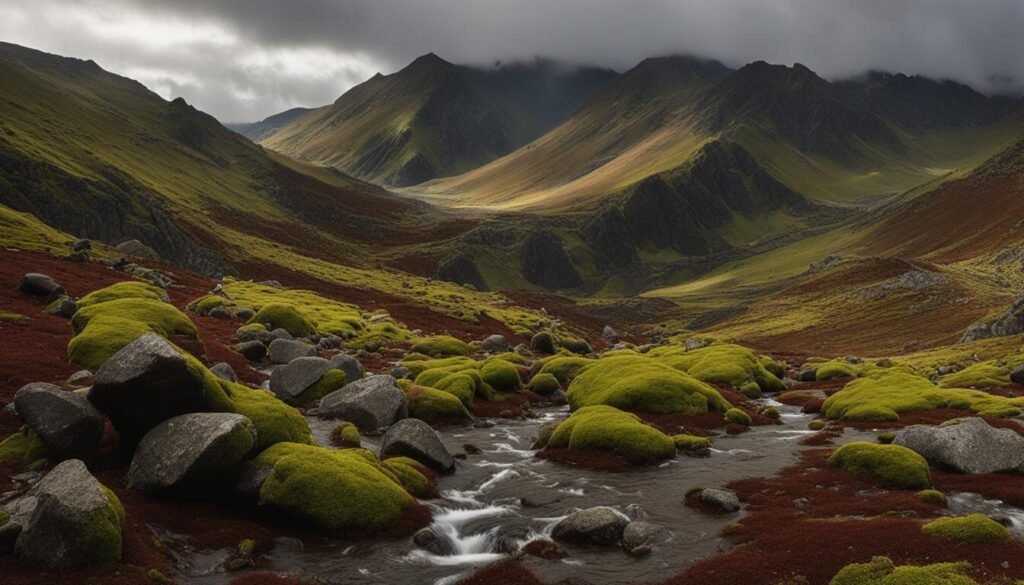
In summary, soil color changes can be a valuable indicator in the search for gold. By observing variations in soil color and understanding the role of small rock and mineral particles, prospectors can improve their chances of discovering potential gold deposits. However, it’s important to remember that successful gold prospecting requires a combination of skills, knowledge, and experience. So, put on your prospecting gear, keep an eye on the soil, and embark on an exciting journey to uncover the hidden treasures of the earth.
The Importance of Iron Staining in Gold Prospecting
When it comes to gold prospecting, understanding the importance of iron staining is crucial. Iron staining can provide valuable insights into the presence of gold in an area. It is characterized by reddish soils and quartz pieces with dark red stains, indicating high iron content. These iron-rich areas often coincide with potential gold deposits.
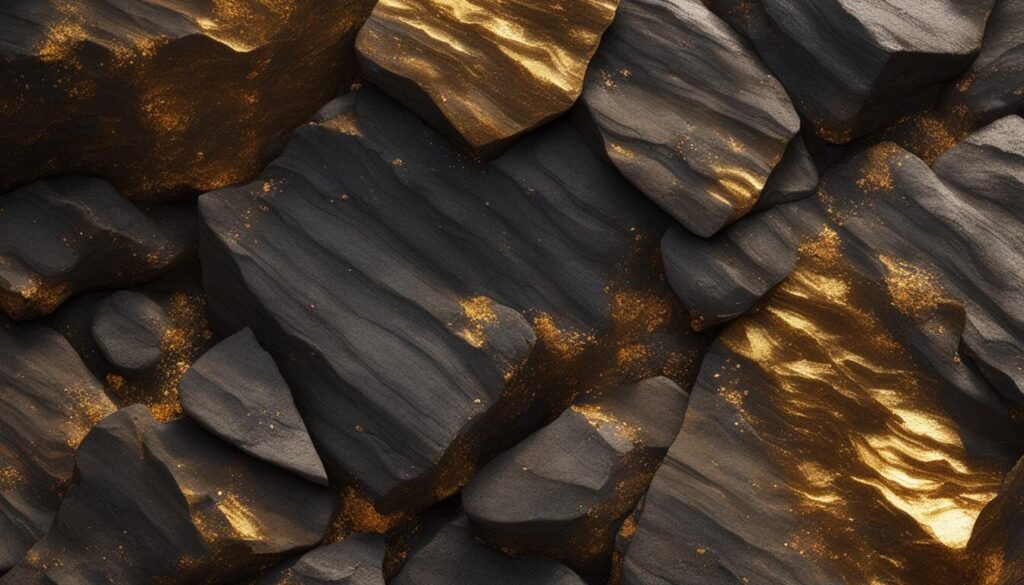
The reddish soils and dark red stains on quartz can be easily observed in the field, making iron staining a valuable indicator for prospectors. These iron-rich areas are formed as iron minerals oxidize, creating distinct coloration. By recognizing and analyzing iron staining patterns, prospectors can narrow down their search for gold and increase their chances of finding valuable deposits.
The Role of Iron Staining
Iron staining serves as a clue that the area has undergone geological processes conducive to gold formation. As gold is often associated with iron minerals, areas with high iron content are more likely to contain gold deposits. Prospectors can use iron staining as a guide to determine where to focus their efforts and prospect more systematically.
Identifying Potential Gold Deposits
When prospecting in areas with reddish soils and quartz pieces with dark red stains, it is important to collect samples for further analysis. A laboratory analysis can confirm the presence of gold and other important minerals associated with it. By combining the visual identification of iron staining with scientific analysis, prospectors can gain a comprehensive understanding of the potential for gold deposits in a given area.
In summary, iron staining plays a vital role in gold prospecting. It serves as a visual indicator of high iron content, which is often associated with gold deposits. By recognizing the presence of reddish soils and quartz pieces with dark red stains, prospectors can focus their efforts on areas with a higher likelihood of containing valuable gold deposits. Analyzing these iron-rich areas and conducting further scientific analysis can provide valuable insights into potential gold deposits and increase the chances of a successful prospecting venture.
Identifying Gold Ore Through Eroding Rocks
When it comes to gold prospecting, one of the signs that can indicate the presence of gold is eroding rocks. In areas where different rocks come together, the erosion process can expose gold-bearing materials, making it easier to identify potential gold deposits. Eroding rocks often have a loose structure and may crumble easily when touched. This characteristic can be a valuable clue for prospectors searching for gold.
Another indicator of gold presence in eroding rocks is the presence of “rotten” quartz. Rotten quartz is a term used to describe quartz that has undergone weathering processes, resulting in a disintegration of its structure. This breakdown can release gold particles that were trapped within the quartz, making it a valuable indicator of gold presence. By recognizing the loose structure of eroding rocks and identifying rotten quartz, prospectors can focus their efforts on areas with higher potential for finding gold.
| Indicator | Description |
|---|---|
| Loose Structure | Eroding rocks have a loose, crumbly structure, making them easier to break apart and examine for the presence of gold. |
| Rotten Quartz | “Rotten” quartz refers to quartz that has undergone weathering, leading to the breakdown of its structure. This can release gold particles and serve as a sign of gold presence. |
As you explore potential gold-bearing areas, keep an eye out for eroding rocks with a loose structure and rotten quartz. These indicators can provide valuable clues, guiding you towards areas that hold the potential for finding gold. Remember to observe and analyze the geological characteristics of the eroding rocks to gain a deeper understanding of the gold-rich environment you are prospecting in.
By incorporating the identification of eroding rocks into your gold prospecting techniques, you can enhance your chances of a successful venture. Remember to conduct thorough research, learn about other geological indicators, and utilize online resources to further develop your prospecting skills. Gold prospecting is an exciting journey that requires patience, perseverance, and a keen eye for the signs that nature reveals.
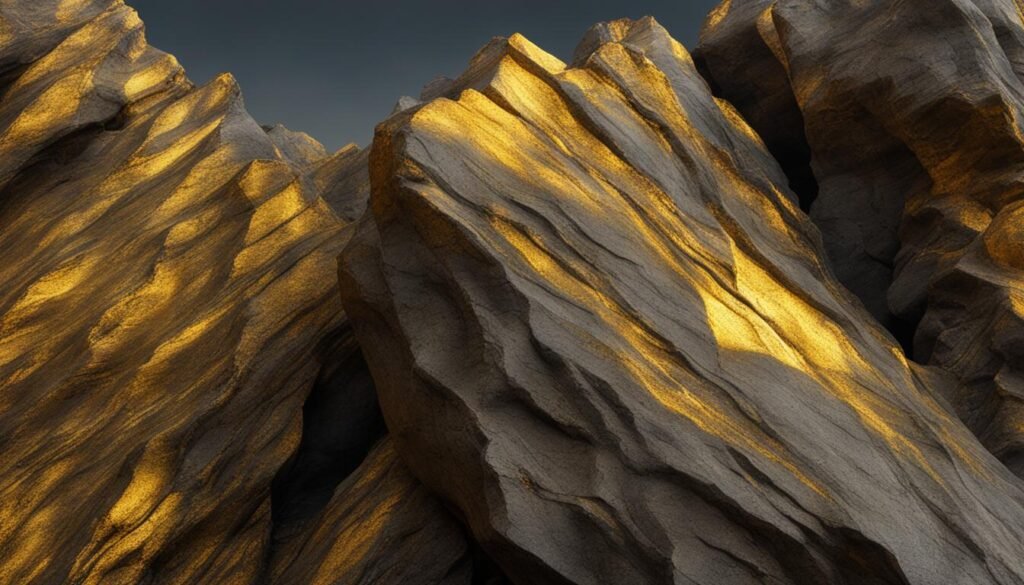
Minerals Associated with Gold
In your gold prospecting journey, it’s crucial to understand the minerals associated with gold. Conducting thorough prospecting research and being familiar with these minerals can greatly increase your chances of finding gold deposits. Let’s explore some of the key minerals commonly found with gold:
1. Quartz
Quartz is one of the primary minerals associated with gold. It often occurs in veins alongside gold deposits. The presence of quartz can indicate the potential for gold-bearing ores. Pay close attention to quartz-rich rocks during your prospecting trips.
2. Pyrite
Pyrite, also known as Fool’s Gold, is another mineral commonly found with gold. It has a metallic luster and a brassy yellow color. While pyrite itself is not valuable, its presence often indicates the potential for gold nearby. Keep an eye out for this mineral during your prospecting efforts.
3. Chalcopyrite
Chalcopyrite is a copper iron sulfide mineral that can be found in association with gold. It has a yellow-gold color and a metallic luster. Chalcopyrite is often found in veins or disseminated throughout rocks near gold deposits. Its presence can be a strong indicator of gold potential.
These are just a few examples of the minerals commonly associated with gold. It’s important to conduct thorough research and familiarize yourself with the specific minerals relevant to your prospecting area. By understanding the minerals associated with gold, you’ll be equipped with valuable knowledge as you embark on your gold prospecting journey.
| Mineral | Appearance | Association with Gold |
|---|---|---|
| Quartz | Translucent, white to gray, sometimes with a rose tint | Often occurs in veins alongside gold deposits |
| Pyrite | Metallic luster, brassy yellow color | Presence indicates potential for gold nearby |
| Chalcopyrite | Yellow-gold color, metallic luster | Found in veins or disseminated near gold deposits |

“Understanding the minerals associated with gold is essential in gold prospecting.” – Gold Prospecting Expert
Researching and Learning about Gold Prospecting
In order to become a successful gold prospector, it is crucial to invest time and effort into researching and learning about various aspects of the field. By conducting thorough prospecting research, you can enhance your understanding of gold indicators, the geology of a mining area, and effective gold prospecting techniques. This knowledge will significantly increase your chances of finding gold and making your prospecting journey a more fruitful one.
One of the key aspects of prospecting research is studying gold indicators. These indicators can include rock-type changes, soil color changes, iron staining, eroding rocks, and the presence of various minerals associated with gold. By familiarizing yourself with these indicators, you will be able to identify potential areas with higher chances of finding gold deposits.
Another important aspect of research is understanding the geology of a mining area. Different rock types and geological formations play a significant role in the formation and presence of gold deposits. By studying the geology of a specific area, you can gain valuable insights into the potential locations where gold may be found, enabling you to focus your prospecting efforts more effectively.
“Research is essential in gold prospecting. It provides you with the knowledge and tools necessary to make informed decisions and increase your chances of success in finding gold.” – Experienced Prospector
Furthermore, researching different gold prospecting techniques can greatly improve your skills and increase your chances of finding gold. There are various techniques that prospectors use, such as metal detecting, drywashing, sluicing, and panning. Understanding these techniques and honing your skills through practice will enhance your ability to identify gold deposits and recover gold effectively.
Table: Prospecting Research Tips
| Research Tip | Description |
|---|---|
| Read Books and Websites | Explore books and websites dedicated to gold prospecting to gain knowledge about various prospecting techniques, gold indicators, and geology. |
| Join Mining Clubs | Join local mining clubs to connect with experienced prospectors and learn from their expertise through workshops and field trips. |
| Attend Classes and Workshops | Enroll in prospecting classes and workshops to gain hands-on experience, learn advanced techniques, and receive guidance from experts. |
| Watch YouTube Videos | YouTube offers a vast collection of videos on gold prospecting, where experienced prospectors share their knowledge, techniques, and tips. |
| Engage in Prospecting Forums | Participate in online prospecting forums to connect with fellow prospectors, ask questions, and exchange valuable information. |
By investing time and effort in prospecting research and learning about gold indicators, the geology of a mining area, and gold prospecting techniques, you can significantly increase your chances of success in finding gold deposits. Remember, knowledge is the key to a successful and rewarding prospecting journey.

The Art of River Panning in Gold Prospecting
In the world of gold prospecting, river panning is a time-tested and effective method used in placer mining to extract gold from stream deposits. This traditional technique involves using a pan to wash gold-bearing gravel or other material, allowing the gold to settle and be collected. River panning is not only a cost-effective method but also an exciting way to discover gold. To successfully engage in river panning, you must identify suitable locations with rocks, gravel, and flowing water.
As you embark on your river panning adventure, it’s essential to acquire the proper skills and techniques for successful gold recovery. The process begins by filling your pan with material from the riverbed. Submerge the pan in the water and vigorously agitate it to separate the gold from the surrounding sediment. The heavy gold particles will sink to the bottom, while the lighter material is washed away. By carefully swirling and tilting the pan, you can concentrate the gold in one area, making it easier to recover.
Once you have separated the gold from the unwanted material, carefully remove any remaining rocks or debris. Use a snuffer bottle or tweezers to collect the gold, taking care not to lose any precious flakes or nuggets. Remember to always respect the environment and adhere to any local regulations regarding the use of pans and other equipment.
With practice and patience, river panning can be a rewarding and fulfilling endeavor. It allows you to connect with nature while searching for the elusive treasure hidden within stream deposits. So, grab your pan, head to a suitable river location, and embark on your own gold prospecting journey.

Table: Comparison of Gold Recovery Techniques
| Technique | Pros | Cons |
|---|---|---|
| River Panning | Low cost, minimal equipment required | Limited capacity, manual labor-intensive |
| Sluicing | Increased processing capacity, can capture small and large gold particles | Requires more equipment and setup, water source needed |
| Dredging | Potentially high gold recovery, large-scale production | Expensive equipment, permits and regulations |
| Gold Trommel | Efficient processing of larger volumes of material | Higher initial cost, requires water and power source |
Table: Comparison of Gold Recovery Techniques
Utilizing Online Resources for Gold Prospecting
When it comes to gold prospecting, the internet is a treasure trove of valuable resources. Online platforms provide a wealth of information, guidance, and community support for aspiring prospectors. Whether you’re a beginner or experienced prospector, utilizing online resources can enhance your research and increase your chances of finding gold.
One of the most popular online resources for gold prospecting is YouTube. You can find a wide range of informative videos that cover various aspects of prospecting, from equipment reviews to techniques and tips from experienced prospectors. Watching these videos can provide valuable insights and help you refine your prospecting skills.
Prospecting forums are another valuable online resource. Joining these forums allows you to connect with fellow prospectors, share knowledge, and learn from their experiences. These communities are a great platform to ask questions, seek advice, and receive feedback on your prospecting methods. Engaging with others who share the same passion can be incredibly beneficial in your gold prospecting journey.
“The internet provides access to a wealth of information, including websites, forums, and YouTube videos. These resources offer guidance on where to look for gold, what equipment to use, and how to pan for gold.”
Aside from videos and forums, there are numerous websites dedicated to gold prospecting. These websites provide comprehensive information about prospecting techniques, geology, and the history of gold mining in different regions. They often feature maps, articles, and even downloadable guides that can be extremely useful for both new and experienced prospectors.
In conclusion, online resources are invaluable tools for gold prospecting. The wealth of information available on the internet, from YouTube videos to prospecting forums and dedicated websites, can enhance your knowledge, improve your techniques, and connect you with a community of like-minded individuals. As you embark on your gold prospecting journey, take advantage of these online resources to increase your chances of success and make the most out of your adventure.
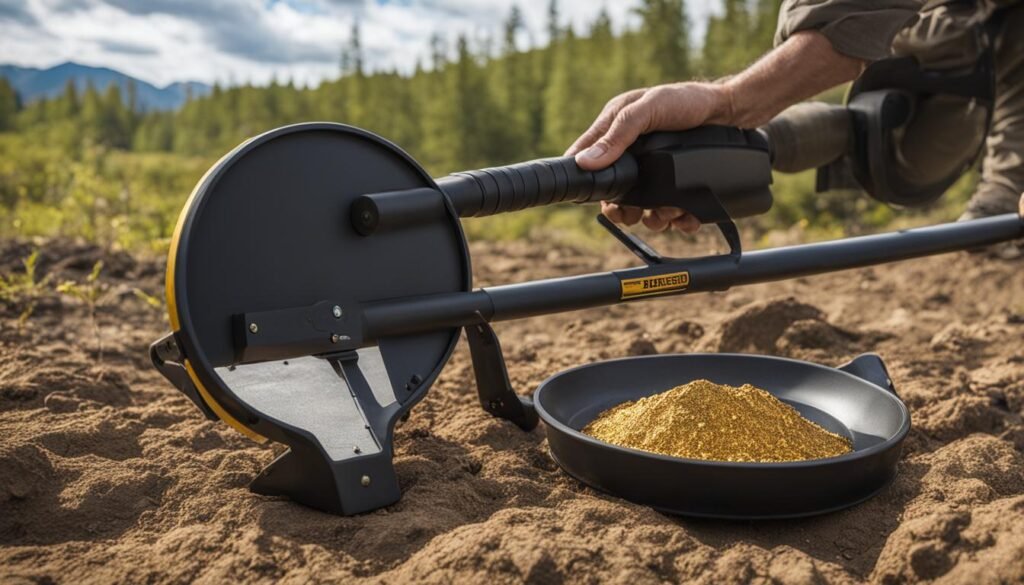
Table: Online Resources for Gold Prospecting
| Resource | Description |
|---|---|
| YouTube | A platform with a wide range of videos providing guidance, techniques, and tips for gold prospecting. |
| Prospecting Forums | Online communities where you can connect with experienced prospectors, ask questions, and share knowledge. |
| Dedicated Websites | Websites offering comprehensive information on prospecting techniques, geology, and regional gold mining history. |
Understanding Legalities and Land Ownership in Gold Prospecting
In the world of gold prospecting, it is essential to have a thorough understanding of the legalities and land ownership regulations that govern the industry. Whether you are prospecting on public land or private property, compliance with mining laws is crucial to ensure a smooth and legally sound operation.
When it comes to prospecting on private land, it is essential to obtain permission from the landowners before beginning any exploration activities. Respect for private property rights is paramount, and seeking proper authorization demonstrates your commitment to ethical and responsible prospecting practices.
Prospecting on public land requires knowledge of the specific mining laws and regulations that govern the area. Each jurisdiction may have its own set of rules and guidelines for entry, exploration, and mining activities. Familiarizing yourself with these legal requirements not only helps you stay within the boundaries of the law but also allows you to maximize your prospecting potential in public areas.
The Importance of Land Ownership Documentation
One critical aspect of understanding land ownership in gold prospecting is ensuring you have accurate and up-to-date documentation. This documentation may include land title deeds, leases, or permits that grant you the right to prospect on a specific piece of land. By having the proper documentation in place, you can avoid unnecessary disputes and legal complications that may arise.
| Prospecting on Public Land | Prospecting on Private Land |
|---|---|
| Understand and adhere to the mining laws and regulations specific to the public land. | Obtain permission from the landowner before conducting any prospecting activities. |
| Familiarize yourself with any permit requirements or restrictions on prospecting in the area. | Respect private property rights and follow any guidelines or restrictions set by the landowner. |
| Be aware of any environmental impact assessments or mitigation measures that may apply. | Communicate with the landowner to establish boundaries and any special considerations for prospecting. |
By understanding the legalities and land ownership regulations associated with gold prospecting, you can ensure that your activities are conducted in a responsible and compliant manner. This knowledge not only protects you from legal issues but also promotes the sustainability and preservation of our natural resources.
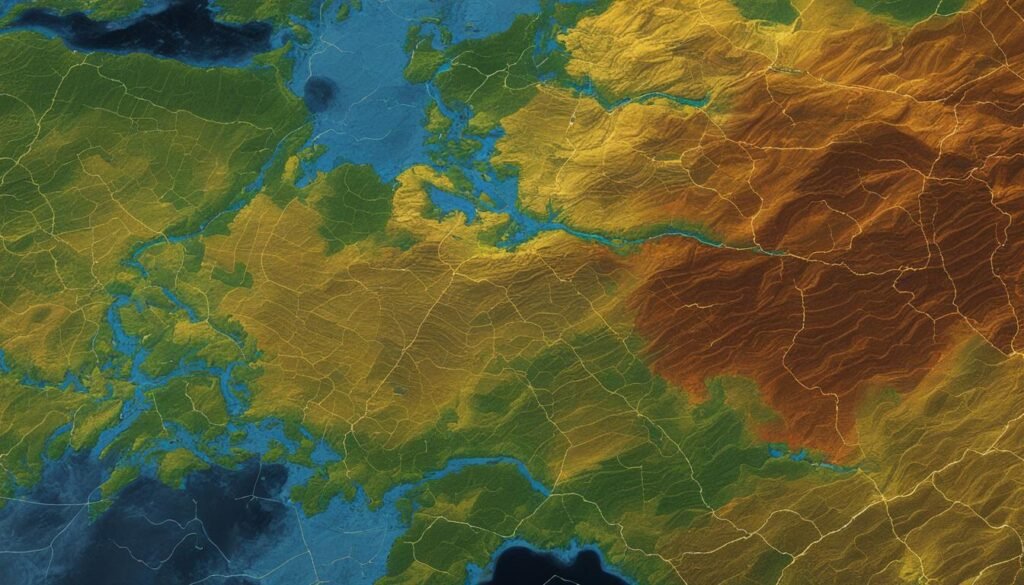
Conclusion
Gold prospecting is a challenging yet rewarding venture that requires dedication, research, and systematic studies. While finding gold is not guaranteed, the knowledge and adventure gained during the prospecting journey make it a worthwhile endeavor. To increase your chances of success, thorough research is essential. Familiarize yourself with geological indicators and gold prospecting techniques specific to the area you are exploring.
Utilizing online resources such as websites, forums, and YouTube videos can provide valuable guidance and insights from experienced prospectors. Joining prospecting clubs and attending classes can also expand your knowledge and skills in the field. Additionally, understanding the legalities and land ownership rights associated with gold prospecting is crucial to ensure you are operating within the law.
Remember, gold prospecting is a successful venture when approached with determination and a systematic approach. By conducting thorough research, learning from experienced prospectors, and staying persistent, you increase your chances of finding gold. Embrace the excitement and challenges of the journey, and enjoy the thrill of potentially uncovering a precious gold nugget.
FAQ about How to Identify Gold Ore
How do I identify gold ore?
Gold ore can be identified through various signs, including rock-type changes, soil color changes, iron staining, eroding rocks, and the presence of various minerals associated with gold. By observing these signs, you can increase your chances of finding gold deposits.
What are the signs to watch out for during a prospecting trip?
Five signs to watch out for during a prospecting trip include rock-type changes, soil color changes, iron staining, eroding rocks, and the presence of various minerals. These signs can indicate the presence of gold in an area and help you find gold nuggets or deposits.
Why is geological knowledge important in gold prospecting?
Geological knowledge is crucial in gold prospecting as gold deposits are often found in areas where different rock types come together. Understanding rock types and their changes can help identify potential gold deposits. Additionally, knowledge of the geology of a mining area can provide valuable information about the presence of gold and associated minerals.
How does soil help in identifying gold ore?
Soil can help in identifying gold ore through changes in color. Small particles of rock and mineral in the soil can indicate potential gold deposits. By observing soil color changes, prospectors can identify areas where gold may be present.
Why is iron staining important in gold prospecting?
Iron staining is important in gold prospecting as it indicates the presence of high iron content and potential gold deposits. Reddish soils and quartz pieces with dark red stains are signs of iron staining and can be indicators of gold presence.
How do eroding rocks help in identifying gold ore?
Eroding rocks can indicate the presence of gold. If you come across easily crumbling rocks and “rotten” quartz, it suggests gold presence in the area. These loose structures can be indicators of gold deposits.
What minerals are associated with gold?
Gold presence is often associated with well-known minerals. Conducting research and being familiar with various types of minerals in a certain location can increase the chances of finding gold deposits. Understanding the minerals associated with gold is essential in gold prospecting.
How can I research and learn about gold prospecting?
Researching and learning about gold prospecting is crucial for success. You can conduct research through books, websites, mining reports, and local prospecting clubs. Joining a prospecting club and attending classes can provide valuable knowledge and tips for successful prospecting.
What is river panning in gold prospecting?
River panning is a traditional method used in placer mining to extract gold from stream deposits. It involves using a pan to wash gold-bearing gravel or other material. River panning can be a cost-effective and exciting way to find gold, but it requires suitable locations with rocks, gravel, and flowing water, as well as proper skills and techniques for successful gold recovery.
How can I utilize online resources for gold prospecting?
Online resources such as websites, forums, and YouTube videos are valuable tools for gold prospecting. They offer guidance on where to look for gold, what equipment to use, and how to pan for gold. Joining prospecting forums allows knowledge sharing and learning from experienced prospectors.
Why is understanding legalities and land ownership important in gold prospecting?
Understanding legalities and land ownership is essential in gold prospecting. Permission must be obtained from landowners to prospect on private land, and knowledge of mining laws and regulations is crucial when prospecting on public land. Different rules and regulations govern entry into public lands for prospecting purposes.
Source Links
- https://pubs.usgs.gov/gip/prospect2/prospectgip.html
- https://www.metaldetector.com/pages/learnbuying-guide-articlesgold-prospectingstep-by-step-guide-to-finding-gold
- https://www.prospectorspatch.com.au/5-signs-to-check-for-gold-pieces-in-rocks-our-prospecting-guide/
